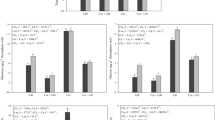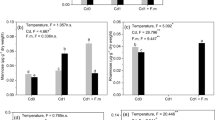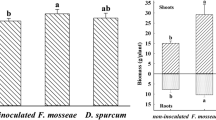Abstract
Global warming and heavy metal-contaminated soils co-occur in natural ecosystems. Flavonoids and phenolic acids in plants have significant antioxidant activity and free radical scavenging ability, which can quickly increase under adverse environments. Arbuscular mycorrhizal fungi (AMF) colonization can affect the synthesis of flavonoids and phenolic acids in host plants. This study focused on the main effect of Glomus mosseae, cadmium (Cd, 8 mg kg−1 dry soils), and elevated temperature (ET, + 3 °C) on main flavonoids and phenolic acids in 120-d Medicago sativa L. (alfalfa). Elevated temperature decreased G. mosseae colonization ratio by 49.5% under Cd exposure. Except for p-hydroxybenzoic acid, flavonoids and phenolic acids content in shoots increased (p < 0.05) under G. mosseae + Cd relative to Cd only. G. mosseae and Cd showed significant effects on rutin, quercetin, apigenin, liquiritigenin, gallic acid, p-hydroxybenzoic acid, p-coumaric acid, and ferulic acid, and G. mosseae colonization led to increases in these compounds by 41.7%, 35.4%, 32.2%, 267.8%, 84.7%, 33.5%, 102.8%, and 89.4%, respectively, under ET + Cd. Carbon, N, and Cd in alfalfa and G. mosseae colonization rate were significant factors on flavonoids and phenolic acids accumulation. Additionally, P content in shoots significantly influenced flavonoids content. G. mosseae inoculation significantly stimulated the synthesis of main flavonoids and phenolic acids in alfalfa shoots under ET + Cd, which was helpful to understand the regulation of AMF on non-enzyme antioxidant system of plants grown in heavy metal-contaminated soils under global change scenarios.




Similar content being viewed by others
Data availability
The dataset analyzed in the current study can be accessed from the manuscript.
References
Abdelhameed RE, Metwally RA (2019) Alleviation of cadmium stress by arbuscular mycorrhizal symbiosis. Int J Phytoremediat 21:663–671
Agati G, Azzarello E, Pollastri S, Tattini M (2012) Flavonoids as antioxidants in plants: Location and functional significance. Plant Sci 196:67–76
Al-Arjani AF, Hashem A, Abd Allah EF (2020) Arbuscular mycorrhizal fungi modulates dynamics tolerance expression to mitigate drought stress in Ephedra foliata Boiss. Saudi J Biol Sci 27:380–392
Bennett AE, Classen AT (2020) Climate change influences mycorrhizal fungal-plant interactions, but conclusions are limited by geographical study bias. Ecology 101(4):e02978
Biermann B, Linderman RG (1981) Quantifying vesicular-arbuscular mycorrhizae: a proposed method towards standardization. New Phytol 87(1):63–67
Bisht A, Garg N (2022) AMF species improve yielding potential of Cd stressed pigeonpea plants by modulating sucrose-starch metabolism, nutrients acquisition and soil microbial enzymatic activities. Plant Growth Regul 96:409–430
Bonfante P, Genre A (2010) Mechanisms underlying beneficial plant–fungus interactions in mycorrhizal symbiosis. Nat Commun 1:48. https://doi.org/10.1038/ncomms1046
Bonoli M, Marconi E, Caboni MF (2004) Free and bound phenolic compounds in barley (Hordeum vulgare L.) flours: evaluation of the extraction capability of different solvent mixtures and pressurized liquid methods by micellar electrokinetic chroma-tography and spectrophotometry. J Chromatogr A 1057:1–12
Bourgaud F, Gravot A, Milesi S, Gontier E (2001) Production of plant secondary metabolites: a historical perspective. Plant Sci 161:839–851
Buer CS, Muday GK, Djordjevic MA (2007) Flavonoids are differentially taken up and transported long distances in Arabidopsis. Plant Physiol 145:478–490
Cabral L, Soares CRFS, Giachini AJ, Siqueira JO (2015) Arbuscular mycorrhizal fungi in phytoremediation of contaminated areas by trace elements: mechanisms and major benefits of their applications. World J Microbiol Biotechnol 31(11):1655–1664
Ceccarelli N, Curadi M, Martelloni L, Sbrana C, Picciarelli P, Giovannetti M (2010) Mycorrhizal colonization impacts on phenolic content and antioxidant properties of artichoke leaves and flower heads two years after field transplant. Plant Soil 335:311–323
Compant S, van der Heijden MGA, Sessitsch A (2010) Climate change effects on beneficial plant–microorganism interactions. FEMS Microbiol Ecol 73:197–214
Cui GJ, Ai SY, Chen K, Wang XR (2019) Arbuscular mycorrhiza augments cadmium tolerance in soybean by altering accumulation and partitioning of nutrient elements, and related gene expression. Ecotoxicol Environ Saf 171:231–239
Dai LP, Xiong ZT, Huang Y, Li MJ (2006) Cadmium-induced changes in pigments, total phenolics, and phenylalanine ammonia-lyase activity in fronds of Azolla imbricata. Environ Toxicol 10:505–512
Dao TTH, Linthorst HJM, Verpoorte R (2011) Chalcone synthase and its functions in plant resistance. Phytochem Rev 10:397–412
Davies KM, Albert NW, Schwinn KE (2012) From landing lights to mimicry: The molecular regulation of flower colouration and mechanisms for pigmentation patterning. Funct Plant Biol 39:619–638
Dixon RA, Paiva NL (1995) Stress-induced phenylpropanoid metabolism. Plant Cell 7:1085–1097
Feng YT, Huang QL, Zhang R, Li JY, Luo K, Chen YH (2022) Molecular characterisation of PAL gene family reveals their role in abiotic stress response in lucerne (Medicago sativa). Crop Pasture Sci 73(3):300–311
Gao C, Kim Y, Zheng Y, Yang W, Chen L, Ji N, Wan SQ, Guo L (2016) Increased precipitation, rather than warming, exerts a strong influence on arbuscular mycorrhizal fungal community in a semiarid steppe ecosystem. Botany 94:459–469
Garg N, Chandel S (2011) Role of arbuscular mycorrhizal (AM) fungi on growth, cadmium uptake, osmolyte, and phytochelatin synthesis in Cajanus cajan (L.) Millsp. under NaCl and Cd stresses. J Plant Growth Regul 31:292–308
Guo FY, Zhu JG, Zhou H, Sun YY, Yin Y, Per DP, Ji R, Wu JC, Wang XR (2011) Elevated CO2 levels affects the concentrations of copper and cadmium in crops grown in soil contaminated with heavy metals under fully open-air field conditions. Environ Sci Technol 45:6997–7003
Halliwell B, Gutteridge JM (2015) Free Radicals in Biology and Medicine. Oxford University Press, Oxford
Hawkes C, Hartley I, Ineson P, Fitter A (2010) Soil temperature affects carbon allocation within arbuscular mycorrhizal networks and carbon transport from plant to fungus. Glob Change Biol 14:1181–1190
Heinemeyer A, Ridgway KP, Edwards EJ, Benham DG, Young JP, Fitter AH (2004) Impact of soil warming and shading on colonization and community structure of arbuscular mycorrhizal fungi in roots of a native grassland community. Glob Change Biol 10:52–64
Jia X, Wang WK, Chen ZH, He YH, Liu JX (2014) Concentrations of secondary metabolites in tissues and root exudates of wheat seedlings changes under atmospheric CO2 and cadmium-contaminated soils. Environ Exp Bot 107:134–143
Jia X, Zhao YH, Liu T, Huang SP (2016a) Elevated CO2 affects secondary metabolites in Robinia pseudoacacia L. seedlings in Cd- and Pb-contaminated soils. Chemosphere 160:199–207
Jia X, Zhao YH, Liu T, Huang SP, Chang YF (2016b) Elevated CO2 increases glomalin-related soil protein (GRSP) in the rhizosphere of Robinia pseudoacacia L. seedlings in Pb- and Cd-contaminated soils. Envrion Pollut 218:349–357
Jia X, Zhang CY, Zhao YH, Liu T, He YH (2018) Three years of exposure to lead and elevated CO2 affects lead accumulation and leaf defenses in Robinia pseudoacacia L. seedlings. J Hazard Mater 349:215–223
Kanwal S, Bano A, Malik AN (2015) Effects of arbuscular mycorrhizal fungi on wheat growth, physiology, nutrition and cadmium uptake under increasing cadmium stress. IJAAR 7:30–42
Kim Y, Gao C, Zheng Y, He X, Yang W, Chen L, Wan SQ, Guo L (2015) Arbuscular mycorrhizal fungal community response to warming and nitrogen addition in a semiarid steppe ecosystem. Mycorrhiza 25:267–276
Kivlin SN, Hawkes CV, Treseder KK (2011) Global diversity and distribution of arbuscular mycorrhizal fungi. Soil Biol Biochem 43:2294–2303
Larose G, Chênevert R, Moutoglis P, Gagné S, Piché Y, Vierheilig H (2002) Flavonoid levels in roots of Medicago sativa are modulated by the developmental stage of the symbiosis and the root colonizing arbuscular mycorrhizal fungus. J Plant Physiol 159:1329–1339
Li TQ, Tao Q, Han X, Yang XE (2013) Effects of elevated CO2 on rhizosphere characteristics of Cd/Zn hyperaccumulator Sedum alfredii. Sci Total Environ 454–455:510–516
Li YQ, Kong DX, Fu Y, Sussman MR, Wu H (2020) The effect of developmental and environmental factors on secondary metabolites in medicinal plants. Plant Physiol Bioch 148:80–89
López-Ráez JA, Flors V, García JM, Pozo MJ (2010) AM symbiosis alters phenolic acid content in tomato roots. Plant Signal Behav 5:1138–1140
Ma DY, Li YG, Zhang J, Wang CY, Qin HX, Ding HN, Xie YX, Guo TC (2016) Accumulation of phenolic compounds and expression profiles of phenolic acid biosynthesis-related genes in developing grains of white, purple, and red wheat. Front Plant Sci 7:528
MacDonald MJ, D’Cunha GB (2007) A modern view of phenylalanine ammonia lyase. Biochem Cell Biol 85:273–282
Michalak A (2006) Phenolic compounds and their antioxidant activity in plants growing under heavy metal stress. Pol J Environ Stud 15:523–530
Miransari M (2017) Arbuscular mycorrhizal fungi and heavy metal tolerance in plants. In: Wu QS (ed) Arbuscular mycorrhizas and stress tolerance of plants. Springer Nature, Singapore, pp 174–161
Mohammed AE, Alotaibi MO, Elobeid M (2022) Interactive influence of elevated CO2 and arbuscular mycorrhizal fungi on sucrose and coumarin metabolism in Ammi majus. Plant Physiol Bioch 185:45–54
Mongkhonsin B, Nakbanpote W, Hokura A, Nuengchamnong N, Maneechai S (2016) Phenolic compounds responding to zinc and/or cadmium treatments in Gynura pseudochina (L.) DC. extracts and biomass. Plant Physiol Biochem 109:549–560
Monz CA, Hunt HW, Reeves FB, Elliott ET (1994) The response of mycorrhizal colonization to elevated CO2 and climate change in Pascopyrum smithii and Bouteloua gracilis. Plant Soil 165:75–80
Navarro-Torre S, Bessadok K, Flores-Duarte N, Rodríguez-Llorente ID, Caviedes MA, Pajuelo E (2020) Helping legumes under stress situations: inoculation with beneficial microorganisms. In: Hasanuzzaman M (ed) Legume crops – prospects, production and uses. IntechOpen, pp 1–21
Nicholson RL, Hammerschmidt R (1992) Phenolic compounds and their role in disease resistance. Annu Rev Phytopathol 30:369–389
Novriyanti E, Watanabe M, Kitao M, Utsugi H, Uemura A, Koike T (2012) High nitrogen and elevated [CO2] effects on the growth, defense and photosynthetic performance of two eucalypt species. Environ Pollut 170:124–136
Okem A, Stirk WA, Street RA, Southway C, Finnie JF, Staden JV (2015) Effects of Cd and Al stress on secondary metabolites, antioxidant and antibacterial activity of Hypoxis hemerocallidea Fisch. & C.A. Mey Plant Physiol Biochem 97:147–155
Peer WA, Murphy AS (2007) Flavonoids and auxin transport: Modulators or regulators? Trends Plant Sci 2:556–563
Plouznikoff K, Declerck S, Calonne-Salmon M (2016) Mitigating abiotic stresses in crop plants by arbuscular mycorrhizal fungi. In: Vos CMF, Kazan K (eds) Belowground defence strategies in plants, signaling and communication in plants signaling. Springer International Publishing, Switzerland, pp 341–400
Pozo MJ, Jung SC, López-Ráez JA, Azcón-Aguilar C (2010) Impact of arbuscular mycorrhizal symbiosis on plant response to biotic stress: the role of plant defence mecha-nisms. In: Koltai H, Kapulnik Y (eds) Arbuscular mycorrhizas: physiology and function. Springer Publishers, Dordrecht, pp 193–207
Raklami A, Oufdou K, Tahiri AI, Mateos-Naranjo E, Navarro-Torre S, Rodríguez-Llorente ID, Meddich A, Redondo-Gómez S, Pajuelo E (2019) Safe cultivation of Medicago sativa in metal-polluted soils from semi-arid regions assisted by heat-and metallo-resistant PGPR. Microorganisms 7:212
Raklami A, Tahiri A, Bechtaoui N, Abdelhay EG, Pajuelo E, Baslam M, Meddich A, Oufdou K (2020b) Restoring the plant productivity of heavy metal-contaminated soil using phosphate sludge, marble waste, and beneficial microorganisms. J Environ Sci 99:210–221
RaklamiGharmali AAEI, Rahou YA, Oufdou K, Meddich A (2020a) Compost and mycorrhizae application as a technique to alleviate Cd and Zn stress in Medicago sativa. Int J Phytoremediat 23:1–12
Rebecca B, Ylva L, Catherine Z (2009) Arbuscular mycorrhizal fungi ameliorate temperature stress in thermophilic plants. Ecology 90:1378–1388
Rillig MC, Wright SF, Shaw MR, Field CB (2010) Artificial climate warming positively affects arbuscular mycorrhizae but decreases soil aggregate water stability in an annual grassland. Oikos 97:52–58
Vierheilig H, Coughlan AP, Wyss U, Piché Y (1998) Ink and vinegar, a simple staining technique for arbuscular mycorrhizal fungi. Appl Environ Microb 64:5004–5007
Wang YP, Huang J, Gao YZ (2012) Arbuscular mycorrhizal colonization alters subcellular distribution and chemical forms of cadmium in Medicago sativa L. and resists cadmium toxicity. PLoS One 7:e48669
Wang RL, Liu SW, Xin WW, Cheng S, Peng GX, Su YJ, Song ZK (2017) Phenolic acids contents and allelopathic potential of 10-cultivars of alfalfa and their bioactivity. Allelopathy J 40(1):63–70
Wang YT, Ren WJ, Li Y, Xu YF, Teng Y, Christie P, Luo YM (2019) Nontargeted metabolomic analysis to unravel the impact of di (2-ethylhexyl) phthalate stress on root exudates of alfalfa (Medicago sativa). Sci Total Environ 646:212–219
Wang L, Jia X, Zhao YH, Zhang CY, Gao YF, Li XD, Cao KM, Zhang NJ (2021) Effects of elevated CO2 on arbuscular mycorrhizal fungi associated with Robinia pseudoacacia L. grown in cadmium-contaminated soils. Sci Total Environ 768:144453
Wasson AP, Pellerone FI, Mathesius U (2006) Silencing the flavonoid pathway in Medicago truncatula inhibits root nodule formation and prevents auxin transport regulation by rhizobia. Plant Cell 18:1617–1629
Wehner J, Antunes PM, Powell JR, Mazukatow J, Rillig MC (2010) Plant pathogen protection by arbuscular mycorrhizas: a role for fungal diversity? Pedobiologia 53:197–201
Weisshaar B, Jenkins GI (1998) Phenylpropanoid biosynthesis and its regulation. Curr Opin Plant Biol 1:251–257
Wen ZB, Jia ZK, Han QF (2008) Spatio-temporal variability of soil available nutrients and pH value in raw after planting alfalfa. J NW A&F Univ (Nat Sci Ed) 36(11):111–116 in Chinese
Yang YH, Jiang PA (2005) Studies on soil properties of lucerene with different cultivating ages. J Soil Water Conserv 19(2):110–113 in Chinese
Yang RH, Yao Q, Guo J, Long LK, Huang YH, Zhu HH (2010) Influence of P and Cd on the spore germination, hyphal growth and polyphosphate accumulation in extraradical hyphae of Glomus intraradices. Mycosystema 29:421–428
Yang YR, Song YY, Scheller HV, Ghosh A, Ban YH, Chen H, Tang M (2015) Community structure of arbuscular mycorrhizal fungi associated with Robinia pseudoacacia in uncontaminated and heavy metal contaminated soils. Soil Biol Biochem 86:146–158
Yang X, Mariotte P, Guo JX, Hautier Y, Zhang T (2021) Suppression of arbuscular mycorrhizal fungi decreases the temporal stability of community productivity under elevated temperature and nitrogen addition in a temperate meadow. Sci Total Environ 762:143137
Yao Q, Zhu HH, Zen RS (2007) Role of phenolic compounds in plant defence: induced by arbuscular mycorrhizal fungi. Allelopathy J 20:1–14
Yu F, Ge YL, Yang HT, Tian GH (2014) Alfalfa flavonoids overview. Food Ferment Technol 50(1):9–13 in Chinese
Zafarzadeh A, Rahimzadeh H, Mahvi AH (2018) Health risk assessment of heavy metals in vegetables in an endemic esophageal cancer region in Iran. Health Scope 7:e12340
Zang Y, Jiang T, Cong Y, Zheng ZJ, Ouyang J (2015) Molecular characterization of a recombinant Zea mays phenylalanine ammonia-lyase (ZmPAL2) and its application in trans-cinnamic acid production from L-phenylalanine. Appl Biochem Biotech 176(3):924–937
Zavalloni C, Vicca S, Büscher M, Providencia IEDL, Boulois HDD, Declerck S, Nijs I, Ceulemans R (2012) Exposure to warming and CO2 enrichment promotes greater above-ground biomass, nitrogen, phosphorus and arbuscular mycorrhizal colonization in newly established grasslands. Plant Soil 359:121–136
Zhang Y, Li SF, Wu XW (2008) Pressurized liquid extraction of flavoniods from Houtuynia cordata Thunb. Sep Purif Technol 58(3):305–310
Zhang RQ, Zhu HH, Zhao HQ, Yao Q (2013) Arbuscular my corrhizal fungal inoculation increases phenolic synthesis in clover roots via hydrogen peroxide, salicylic acid and nitric oxide signaling pathways. J Plant Physiol 170:74–79
Zhang H, Xu N, Li X, Long J, Sui X, Wu Y, Li J, Wang J, Zhong H, Sun GY (2018) Arbuscular mycorrhizal fungi (Glomus mosseae) improves growth, photosynthesis and protects photosystem II in leaves of Lolium perenne L in cadmium contaminated soil. Front Plant Sci 9:1156
Zhang Y, Yu ZY, Geng FN, Wu TQ, Yang L, Xiao H, Zhao Y, Liu H (2018b) Content determination of total phenolic acids in extract of Taraxacum mongolicum. Food Res Dev 39(3):123–126 In Chinese
Zhang CY, Jia X, Zhao YH, Wang L, Cao KM, Zhang NJ (2021) The combined effects of elevated atmospheric CO2 and cadmium exposure of flavonoids in the leaves of Robinia pseudoacacia L seedlings. Ecotox Environ Safe 210:111878
Zhao YH, Jia X, Wang WK, Liu T, Huang SP, Yang MY (2016) Growth under elevated air temperature alters secondary metabolites in Robinia pseudoacacia L. seedlings in Cd-and Pb-contaminated soils. Sci Total Environ 565:586–594
Zoufan P, Azad Z, Ghahfarokhie AR, Kolahi M (2020) Modification of oxidative stress through changes in some indicators related to phenolic metabolism in Malva parviflora exposed to cadmium. Ecotox Environ Safe 187:109811
Acknowledgements
This work was jointly supported by the National Natural Science Foundation of China (grant Nos. 31870582 and 31270665) and the Project Supported by Shaanxi Key Laboratory of Land Consolidation of China (Program No. 2019TD-01).
Funding
This work was jointly supported by the National Natural Science Foundation of China (grant Nos. 31870582 and 31270665).
Author information
Authors and Affiliations
Contributions
Xia Jia planned and designed the research, analyzed data, wrote, reviewed, and edited the manuscript. Yunjie Wang, Jiamin Zhao, Yunfeng Gao, Chunyan Zhang, Xiaojuan Feng, and Xiaoyi Ding performed experiments.
Corresponding author
Ethics declarations
Ethical approval
Not applicable.
Consent to participate
Not applicable.
Consent for publication
Not applicable.
Competing interests
The authors declare no competing interests.
Additional information
Responsible Editor: Gangrong Shi
Publisher's note
Springer Nature remains neutral with regard to jurisdictional claims in published maps and institutional affiliations.
Rights and permissions
Springer Nature or its licensor (e.g. a society or other partner) holds exclusive rights to this article under a publishing agreement with the author(s) or other rightsholder(s); author self-archiving of the accepted manuscript version of this article is solely governed by the terms of such publishing agreement and applicable law.
About this article
Cite this article
Jia, X., Wang, Y., Zhao, J. et al. Effect of Glomus mosseae, cadmium, and elevated air temperature on main flavonoids and phenolic acids contents in alfalfa. Environ Sci Pollut Res 30, 44819–44832 (2023). https://doi.org/10.1007/s11356-023-25506-7
Received:
Accepted:
Published:
Issue Date:
DOI: https://doi.org/10.1007/s11356-023-25506-7




